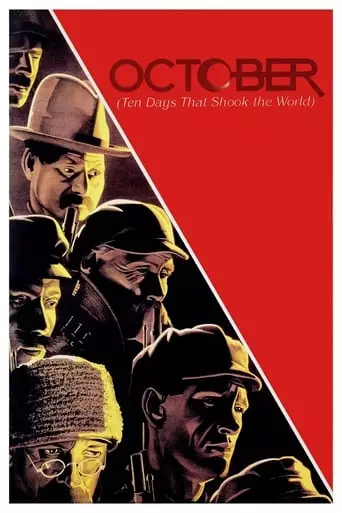
October (Ten Days that Shook the World) (1928) Watch Online Free
Sergei M. Eisenstein’s docu-drama about the 1917 October Revolution in Russia. Made ten years after the events and edited in Eisenstein’s ‘Soviet Montage’ style, it re-enacts in celebratory terms several key scenes from the revolution.
Directed by Sergei Eisenstein and Grigori Aleksandrov, October: Ten Days That Shook the World is a silent Soviet film that dramatizes the 1917 October Revolution in Russia. Commissioned to commemorate the revolution’s tenth anniversary, the film meticulously reconstructs key events from the overthrow of the Tsarist regime to the Bolsheviks’ seizure of the Winter Palace. Eisenstein employs his pioneering intellectual montage technique, juxtaposing disparate images to evoke complex ideas and emotions. For instance, he intercuts scenes of religious icons with military regalia to critique the alliance between church and state. The film does not center on individual protagonists; instead, it portrays the masses as the driving force of historical change, aligning with Marxist ideology.
Upon its release, October received mixed reactions. While it was praised for its innovative cinematic techniques, some contemporaries found its complex montage sequences challenging to interpret. The Soviet authorities criticized the film for being overly formalistic and not easily comprehensible to the general populace. Additionally, due to the political climate, references to Leon Trotsky were removed from the film following his fall from favor. Despite these controversies, October has been recognized as a monumental achievement in film history, showcasing Eisenstein’s mastery of montage and his ability to convey intricate ideological messages through visual storytelling.
October remains one of the most significant films in the history of cinema, not just for its portrayal of the October Revolution, but for its groundbreaking contributions to film technique and its role in Soviet propaganda. Eisenstein’s innovative use of montage became a cornerstone of cinematic theory and practice, influencing generations of filmmakers across the world. The film’s symbolic imagery, rapid editing, and unconventional narrative structure created a new visual language that allowed filmmakers to communicate complex political and social ideas without relying on traditional storytelling methods.
In addition to its technical achievements, October also played a key role in shaping the Soviet Union’s cultural identity. The film was used as a tool for political indoctrination, reinforcing the ideals of the Bolshevik Revolution and the Soviet government’s legitimacy. The film’s portrayal of the people’s revolution, with masses of workers and soldiers uniting to overthrow the Tsarist regime, served as both a celebration of the past and a call to action for future generations.
Despite its mixed reception at the time of its release, October has become an essential part of film history. Its influence extends beyond the realm of Soviet cinema, with directors like Alfred Hitchcock, Jean-Luc Godard, and Andrei Tarkovsky citing Eisenstein as a major influence. The film’s ability to communicate complex political ideas through visual means continues to resonate with audiences and filmmakers alike.
Watching October: Ten Days That Shook the World is likely to leave you with a sense of awe and intellectual engagement. The film’s innovative techniques, its historical context, and its powerful imagery will provoke both emotional and intellectual responses. You may feel inspired by the revolutionary spirit depicted on screen, yet also reflective on the costs and consequences of such upheaval. The film’s critique of authority, the portrayal of collective action, and the symbolic use of imagery may spark discussions on power, revolution, and the role of the individual within the masses.
While the film is undoubtedly a work of propaganda, its artistic merit and historical significance make it a compelling watch for anyone interested in the intersection of politics and cinema. By the end of the film, you will likely appreciate Eisenstein’s mastery in conveying complex ideological messages through visual storytelling, and you may feel a renewed sense of the power of film to influence, educate, and inspire.
October is not just a historical account of the 1917 revolution, but an enduring piece of cinema that continues to challenge and engage audiences with its bold artistic choices and its exploration of revolutionary ideals.
